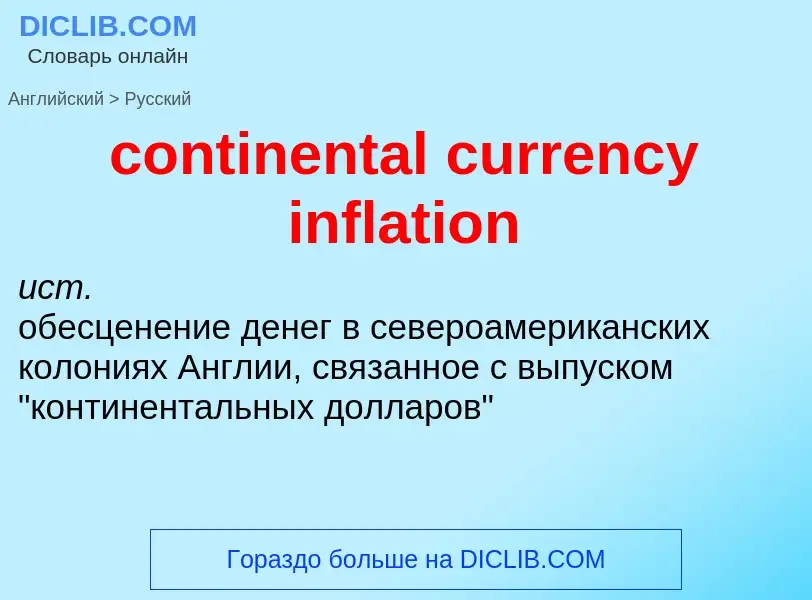Translation and analysis of words by ChatGPT artificial intelligence
On this page you can get a detailed analysis of a word or phrase, produced by the best artificial intelligence technology to date:
- how the word is used
- frequency of use
- it is used more often in oral or written speech
- word translation options
- usage examples (several phrases with translation)
- etymology
continental currency inflation - translation to russian
обесценение денег в североамериканских колониях Англии, связанное с выпуском "континентальных долларов"
Definition
Старинная французская золотая или серебряная монета с изображением геральдического щита.
2. м. нескл.
Валютная счетная единица, используемая странами - членами Европейской валютной системы с 1979 г.
Wikipedia
.jpg?width=120)
Early American currency went through several stages of development during the colonial and post-Revolutionary history of the United States. John Hull was authorized by the Massachusetts legislature to make the earliest coinage of the colony (the willow, the oak, and the pine tree shilling) in 1652.
Because few coins were minted in the Thirteen Colonies, which later became the United Colonies and then the United States, foreign coins like the Spanish dollar were widely circulated. Colonial governments, at times, issued paper money to facilitate economic activities. The British Parliament passed Currency Acts in 1751, 1764, and 1773 to regulate colonial paper money.
During the American Revolution, the Colonies became independent states. No longer subject to monetary regulations arbitrarily imposed by the British Parliament, the States began to issue paper money to pay for military expenses. The Continental Congress also issued paper money during the Revolution — known as Continental currency — to fund the war effort. To meet the monetary demands of the war, State and Continental governments printed large amounts of currency, leading to rapid depreciation. By the end of the war, these paper notes became effectively worthless. Additionally, British counterfeiting gangs contributed further to the decreased value. By its conclusion, only a few counterfeiters had been caught and preemptively hanged, for the crime.

.jpg?width=200)


-Connecticut -2 Jan 1775 OBV.jpg?width=200)
-Connecticut -2 Jan 1775 REV.jpg?width=200)
-Delaware-1 Jan 1776 OBV.jpg?width=200)
-Delaware-1 Jan 1776 REV.jpg?width=200)
-Georgia-4 May 1778 OBV.jpg?width=200)
-Georgia-4 May 1778 REV.jpg?width=200)
-Massachusetts-1 May 1741 OBV.jpg?width=200)
-Massachusetts-1 May 1741 REV.jpg?width=200)
-Maryland-1 Mar 1770 OBV.jpg?width=200)
-Maryland-1 Mar 1770 REV.jpg?width=200)
-North Carolina-27 Nov 1729 OBV.jpg?width=200)
-North Carolina-27 Nov 1729 REV.jpg?width=200)
-New Hampshire-29 Apr 1780 OBV.jpg?width=200)
-New Hampshire-29 Apr 1780 REV.jpg?width=200)
-New Jersey-25 Mar 1776 OBV.jpg?width=200)
-New Jersey-25 Mar 1776 REV.jpg?width=200)
-New York-2 Aug 1775 OBV.jpg?width=200)
-New York-2 Aug 1775 REV.jpg?width=200)
![David Hall]] in 1764. David Hall]] in 1764.](https://commons.wikimedia.org/wiki/Special:FilePath/US-Colonial (PA-115)-Pennsylvania-18 Jun 1764.jpg?width=200)
-Pennsylvania-20 Mar 1771 OBV.jpg?width=200)
-Pennsylvania-20 Mar 1771 REV.jpg?width=200)
-Rhode Island-2 Jul 1780 OBV.jpg?width=200)
-Rhode Island-2 Jul 1780 REV.jpg?width=200)
-South Carolina-8 Feb 1779 OBV.jpg?width=200)
-South Carolina-8 Feb 1779 REV.jpg?width=200)
-Virginia-4 Mar 1773 OBV.jpg?width=200)
-Virginia-4 Mar 1773 REV.jpg?width=200)
